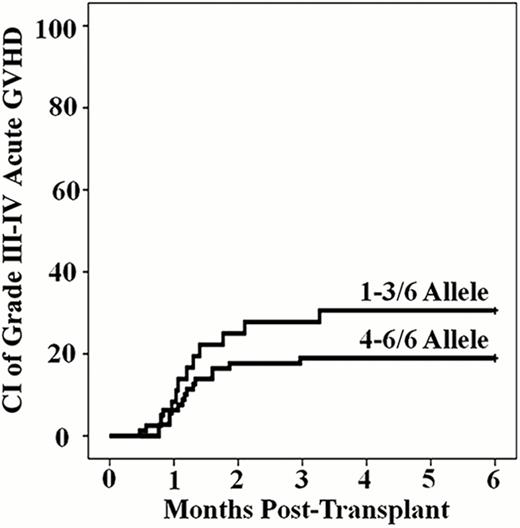Abstract
Abstract  4197
4197
Graft-versus-host disease (GVHD) has emerged as a major cause of morbidity and mortality after double-unit cord blood transplantation (DCBT), but data concerning its manifestations, treatment response, and risk factors are limited. Moreover, the incidence and clinical characteristics of GVHD after day 100 in DCBT recipients have not been well described.
We evaluated the incidence and nature of GVHD in 115 DCBT recipients (median 37 years, range 0.9–69) transplanted for hematologic malignancies with either myeloablative (n = 88) or non-myeloablative conditioning (n = 27). CB units were 4–6/6 human leukocyte antigen (HLA)-A,-B antigen, -DRB1 allele match to the recipient, and all patients received calcineurin-inhibitor/mycophenolate mofetil immunosuppression without anti-thymocyte globulin.
With a median follow-up of 33 months (range 8–73), the cumulative incidences of grade II-IV and III-IV acute GVHD (aGVHD) at day 180 were 53% (95% CI: 44–62) and 23% (95% CI: 15–31), respectively. Among patients with grade II-IV aGVHD, the median onset was 40 days (range 14–169), but earlier for those with grade III-IV (median 35 days). The gastrointestinal (GI) tract was the most commonly affected organ (80%, 14 upper gut, 9 lower gut, 26 both), followed by skin (39%), and liver (18%). Among patients with grade II-IV aGVHD, 29 (48%) were treated with systemic corticosteroids, 27 (44%) with budesonide alone, and 4 (7%) with topical corticosteroids. Budesonide was used as the sole treatment exclusively in adults for grade II disease predominantly affecting the gut. Treatment response by day 28 was 79% and 85% to systemic corticosteroids or budesonide, respectively. Of 89 engrafted patients disease-free at day 100, 54% subsequently had active GVHD with 79% of those affected having persistent/recurrent aGVHD or overlap syndrome. Classical chronic GVHD was quite uncommon affecting only 10 patients (21%) in the study. To take into account potential confounding variables associated with day 180 grade III-IV aGVHD incidence, a multivariate Cox regression analysis was performed (Table). Grade III-IV aGVHD incidence was lower if the engrafting unit-recipient human HLA-A,-B,-DRB1 allele match was > 4/6 (HR 0.385, p = 0.031) (Figure), whereas engrafting unit nucleated cell dose and unit-unit HLA-match were not significant.
GVHD after DCBT was common in our study, predominantly affected the gut, and had a high rate of successful response to treatment. Late GVHD frequently had acute features. Our findings support the consideration of HLA-A,-B,-DRB1 allele donor-recipient (but not unit-unit) HLA-matching in unit selection. This would represent a practice change for most transplant centers. Moreover, new prophylaxis strategies that target the gut are needed.
Multivariate Analysis
| Patient and Graft Characteristics . | Hazard Ratio* . | P value . |
|---|---|---|
| Age (years) | ||
| 0-15 (n = 23) | Reference | |
| >16 (n = 92) | 0.920 (0.358–2.36) | 0.862 |
| CMV serostatus | ||
| Sero-negative (n = 51) | Reference | |
| Sero-positive (n = 64) | 0.570 (0.255–1.275) | 0.171 |
| Engrafting unit TNC ×107/kg | ||
| < 3.0 (n = 94) | Reference | |
| > 3.0 (n = 21) | 2.040 (0.802–5.217) | 0.134 |
| Engrafting unit-recipient 6 allele HLA–match | ||
| 1–3/6 (n = 36) | Reference | |
| 4–6/6 (n = 79) | 0.385 (0.162–0.915) | 0.031 |
| Unit-unit 6 allele HLA-match | ||
| 0–4/6 (n = 88) | Reference | |
| 5–6/6 (n = 27) | 2.204 (0.866–5.609) | 0.097 |
| Patient and Graft Characteristics . | Hazard Ratio* . | P value . |
|---|---|---|
| Age (years) | ||
| 0-15 (n = 23) | Reference | |
| >16 (n = 92) | 0.920 (0.358–2.36) | 0.862 |
| CMV serostatus | ||
| Sero-negative (n = 51) | Reference | |
| Sero-positive (n = 64) | 0.570 (0.255–1.275) | 0.171 |
| Engrafting unit TNC ×107/kg | ||
| < 3.0 (n = 94) | Reference | |
| > 3.0 (n = 21) | 2.040 (0.802–5.217) | 0.134 |
| Engrafting unit-recipient 6 allele HLA–match | ||
| 1–3/6 (n = 36) | Reference | |
| 4–6/6 (n = 79) | 0.385 (0.162–0.915) | 0.031 |
| Unit-unit 6 allele HLA-match | ||
| 0–4/6 (n = 88) | Reference | |
| 5–6/6 (n = 27) | 2.204 (0.866–5.609) | 0.097 |
Includes 95% confidence interval.
Off Label Use: The use of Budesonide for acute gastrointestinal graft-versus-host disease. Giralt:Celgene: Honoraria, Research Funding.
Author notes
Asterisk with author names denotes non-ASH members.

This icon denotes a clinically relevant abstract


This feature is available to Subscribers Only
Sign In or Create an Account Close Modal